FORD F650 2004 11.G Owners Manual
Manufacturer: FORD, Model Year: 2004, Model line: F650, Model: FORD F650 2004 11.GPages: 264, PDF Size: 1.47 MB
Page 131 of 264
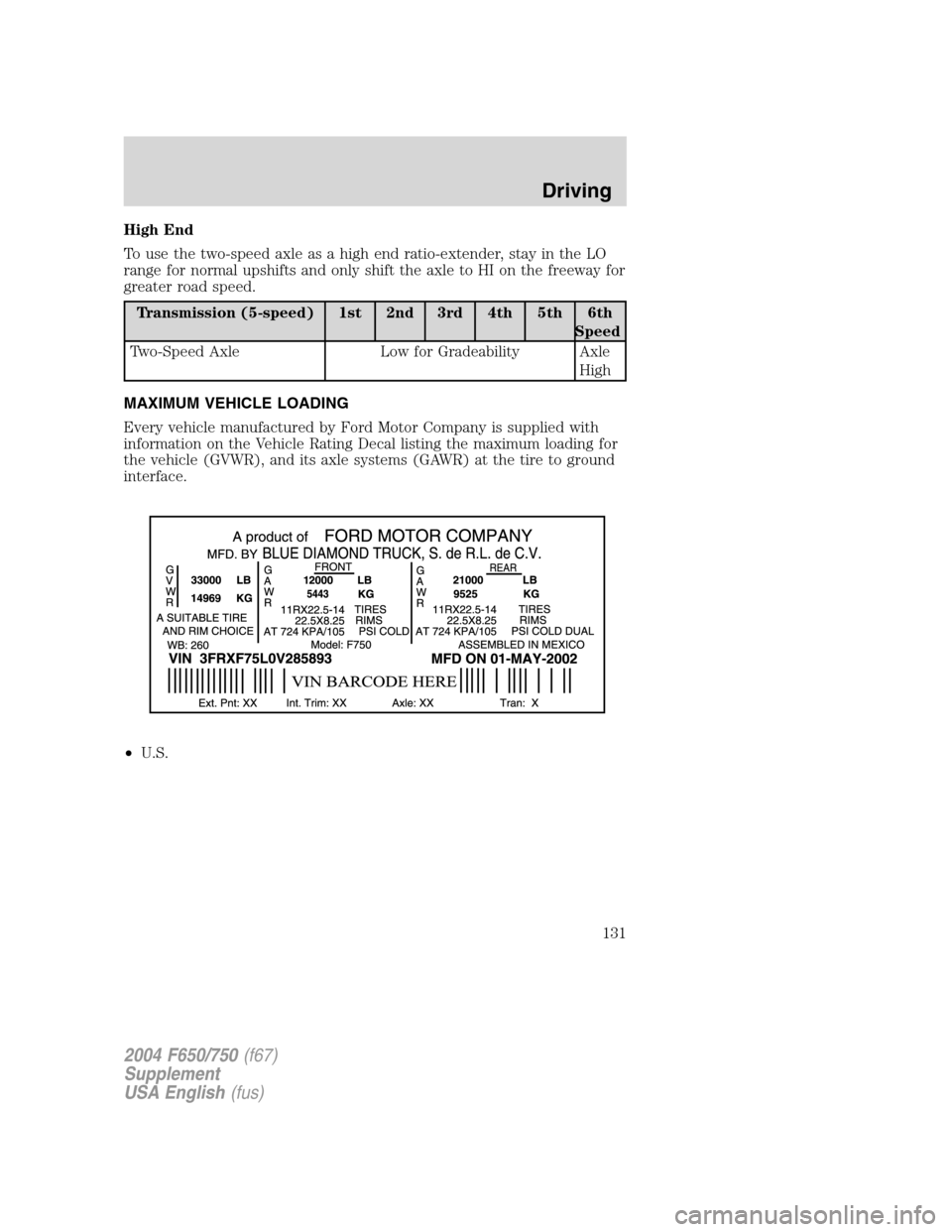
High End
To use the two-speed axle as a high end ratio-extender, stay in the LO
range for normal upshifts and only shift the axle to HI on the freeway for
greater road speed.
Transmission (5-speed) 1st 2nd 3rd 4th 5th 6th
Speed
Two-Speed Axle Low for Gradeability Axle
High
MAXIMUM VEHICLE LOADING
Every vehicle manufactured by Ford Motor Company is supplied with
information on the Vehicle Rating Decal listing the maximum loading for
the vehicle (GVWR), and its axle systems (GAWR) at the tire to ground
interface.
•U.S.
2004 F650/750(f67)
Supplement
USA English(fus)
Driving
131
Page 132 of 264
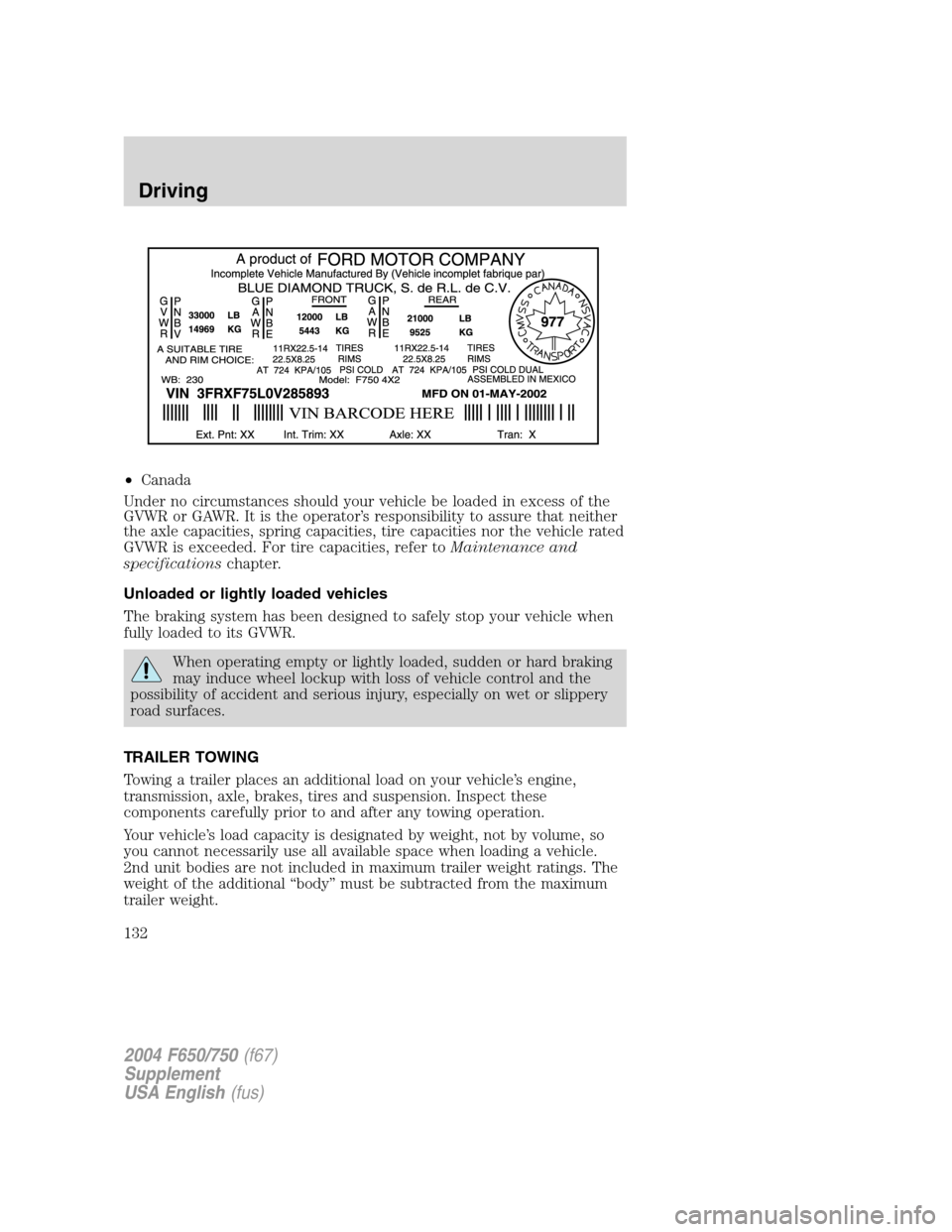
•Canada
Under no circumstances should your vehicle be loaded in excess of the
GVWR or GAWR. It is the operator’s responsibility to assure that neither
the axle capacities, spring capacities, tire capacities nor the vehicle rated
GVWR is exceeded. For tire capacities, refer toMaintenance and
specificationschapter.
Unloaded or lightly loaded vehicles
The braking system has been designed to safely stop your vehicle when
fully loaded to its GVWR.
When operating empty or lightly loaded, sudden or hard braking
may induce wheel lockup with loss of vehicle control and the
possibility of accident and serious injury, especially on wet or slippery
road surfaces.
TRAILER TOWING
Towing a trailer places an additional load on your vehicle’s engine,
transmission, axle, brakes, tires and suspension. Inspect these
components carefully prior to and after any towing operation.
Your vehicle’s load capacity is designated by weight, not by volume, so
you cannot necessarily use all available space when loading a vehicle.
2nd unit bodies are not included in maximum trailer weight ratings. The
weight of the additional“body”must be subtracted from the maximum
trailer weight.
2004 F650/750(f67)
Supplement
USA English(fus)
Driving
132
Page 133 of 264
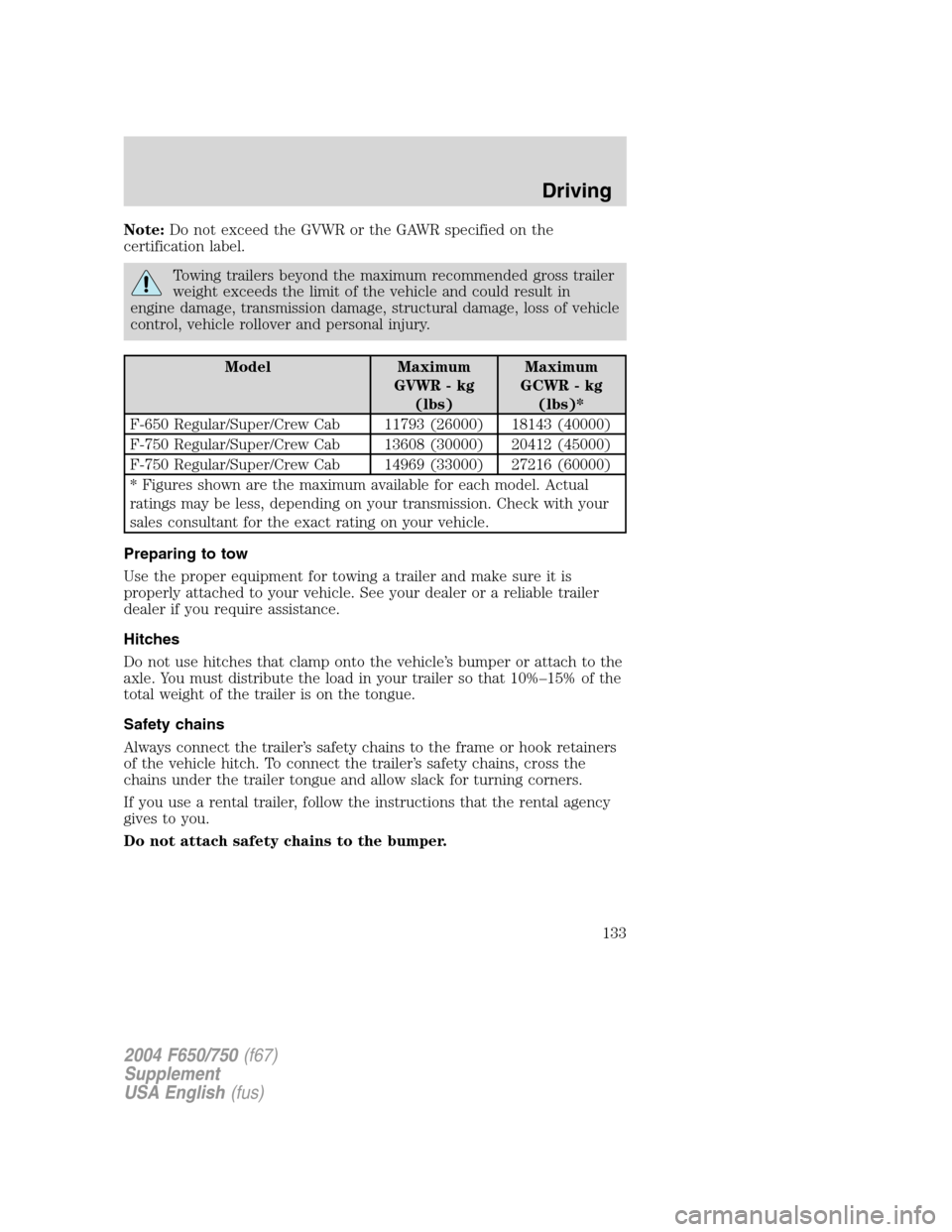
Note:Do not exceed the GVWR or the GAWR specified on the
certification label.
Towing trailers beyond the maximum recommended gross trailer
weight exceeds the limit of the vehicle and could result in
engine damage, transmission damage, structural damage, loss of vehicle
control, vehicle rollover and personal injury.
Model Maximum
GVWR - kg
(lbs)Maximum
GCWR - kg
(lbs)*
F-650 Regular/Super/Crew Cab 11793 (26000) 18143 (40000)
F-750 Regular/Super/Crew Cab 13608 (30000) 20412 (45000)
F-750 Regular/Super/Crew Cab 14969 (33000) 27216 (60000)
* Figures shown are the maximum available for each model. Actual
ratings may be less, depending on your transmission. Check with your
sales consultant for the exact rating on your vehicle.
Preparing to tow
Use the proper equipment for towing a trailer and make sure it is
properly attached to your vehicle. See your dealer or a reliable trailer
dealer if you require assistance.
Hitches
Do not use hitches that clamp onto the vehicle’s bumper or attach to the
axle. You must distribute the load in your trailer so that 10%–15% of the
total weight of the trailer is on the tongue.
Safety chains
Always connect the trailer’s safety chains to the frame or hook retainers
of the vehicle hitch. To connect the trailer’s safety chains, cross the
chains under the trailer tongue and allow slack for turning corners.
If you use a rental trailer, follow the instructions that the rental agency
gives to you.
Do not attach safety chains to the bumper.
2004 F650/750(f67)
Supplement
USA English(fus)
Driving
133
Page 134 of 264
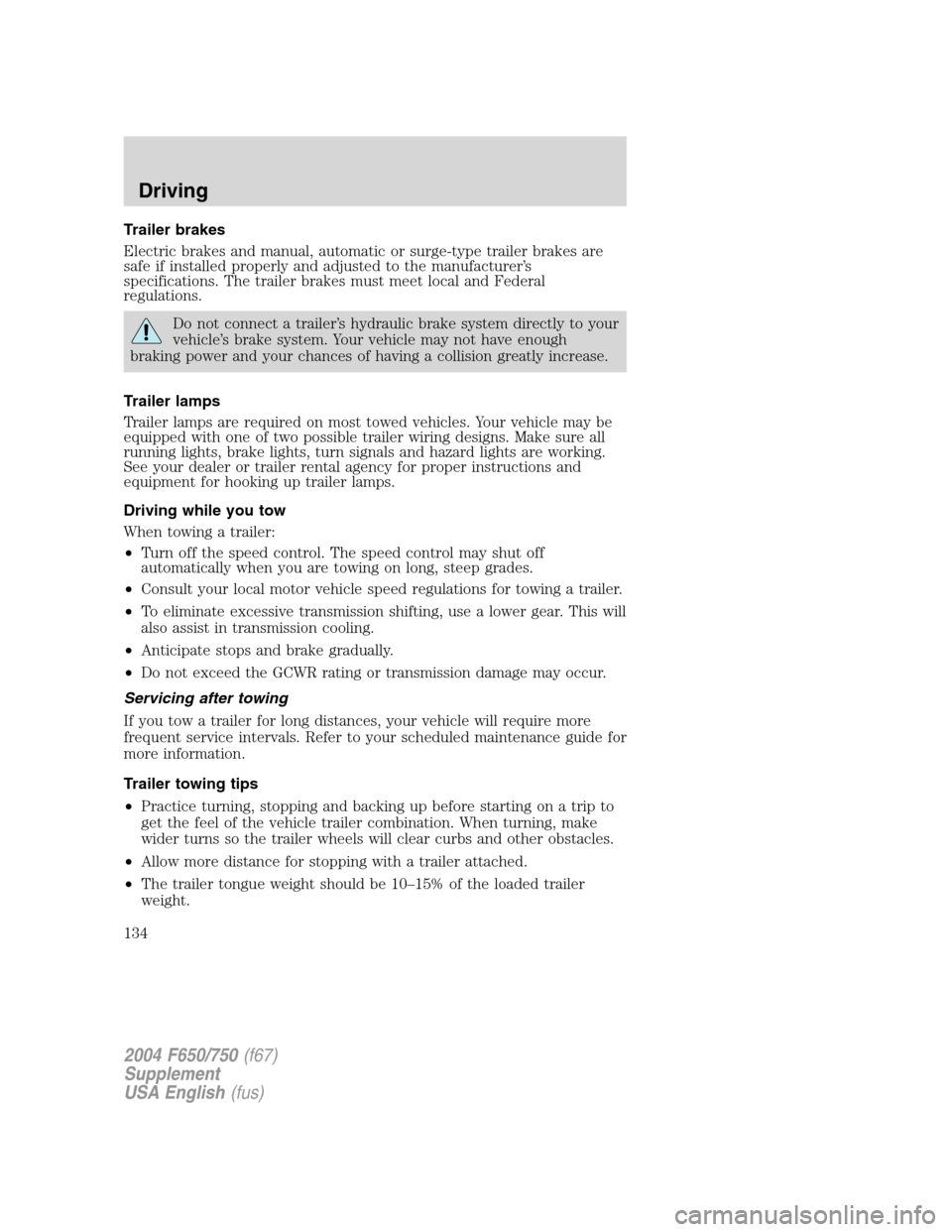
Trailer brakes
Electric brakes and manual, automatic or surge-type trailer brakes are
safe if installed properly and adjusted to the manufacturer’s
specifications. The trailer brakes must meet local and Federal
regulations.
Do not connect a trailer’s hydraulic brake system directly to your
vehicle’s brake system. Your vehicle may not have enough
braking power and your chances of having a collision greatly increase.
Trailer lamps
Trailer lamps are required on most towed vehicles. Your vehicle may be
equipped with one of two possible trailer wiring designs. Make sure all
running lights, brake lights, turn signals and hazard lights are working.
See your dealer or trailer rental agency for proper instructions and
equipment for hooking up trailer lamps.
Driving while you tow
When towing a trailer:
•Turn off the speed control. The speed control may shut off
automatically when you are towing on long, steep grades.
•Consult your local motor vehicle speed regulations for towing a trailer.
•To eliminate excessive transmission shifting, use a lower gear. This will
also assist in transmission cooling.
•Anticipate stops and brake gradually.
•Do not exceed the GCWR rating or transmission damage may occur.
Servicing after towing
If you tow a trailer for long distances, your vehicle will require more
frequent service intervals. Refer to your scheduled maintenance guide for
more information.
Trailer towing tips
•Practice turning, stopping and backing up before starting on a trip to
get the feel of the vehicle trailer combination. When turning, make
wider turns so the trailer wheels will clear curbs and other obstacles.
•Allow more distance for stopping with a trailer attached.
•The trailer tongue weight should be 10–15% of the loaded trailer
weight.
2004 F650/750(f67)
Supplement
USA English(fus)
Driving
134
Page 135 of 264
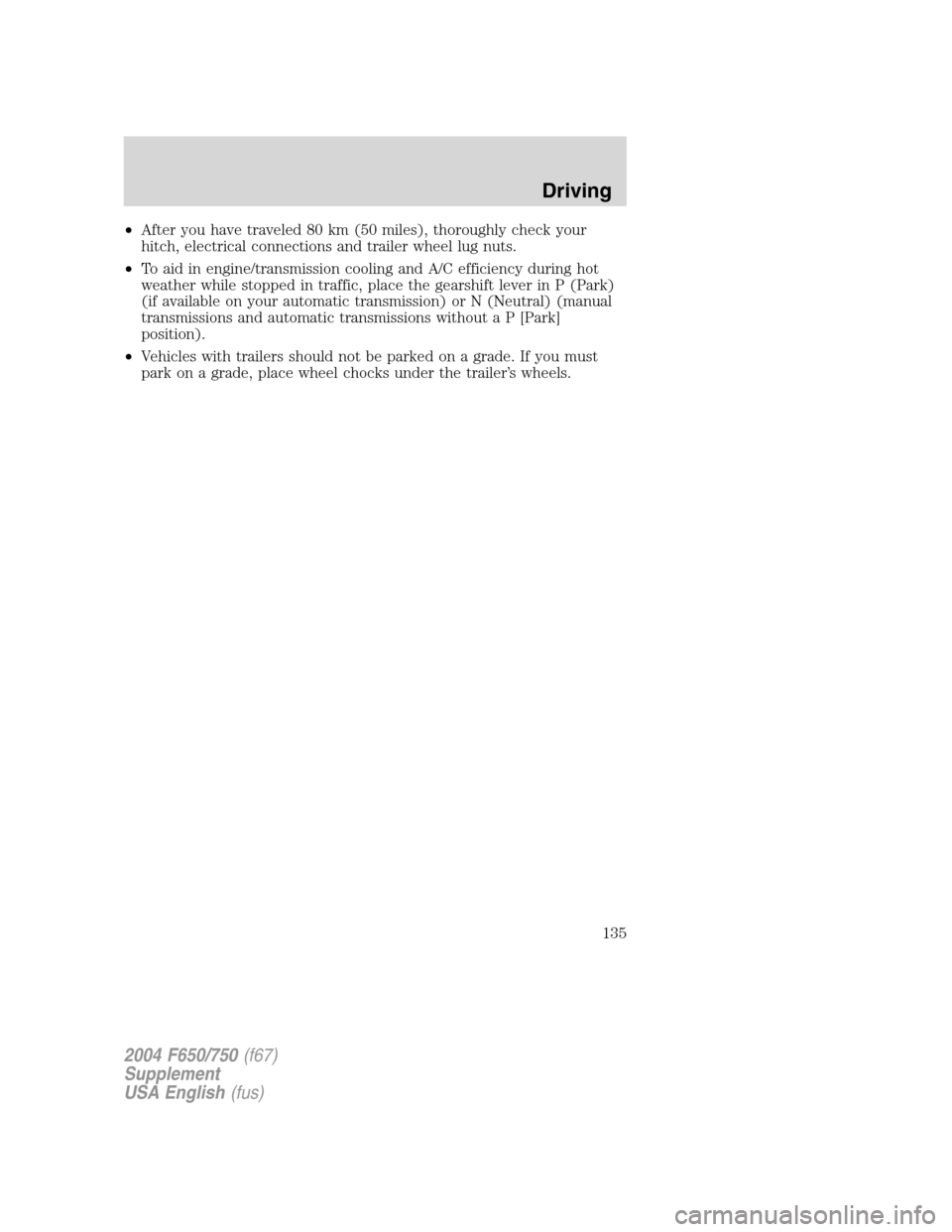
•After you have traveled 80 km (50 miles), thoroughly check your
hitch, electrical connections and trailer wheel lug nuts.
•To aid in engine/transmission cooling and A/C efficiency during hot
weather while stopped in traffic, place the gearshift lever in P (Park)
(if available on your automatic transmission) or N (Neutral) (manual
transmissions and automatic transmissions without a P [Park]
position).
•Vehicles with trailers should not be parked on a grade. If you must
park on a grade, place wheel chocks under the trailer’s wheels.
2004 F650/750(f67)
Supplement
USA English(fus)
Driving
135
Page 136 of 264
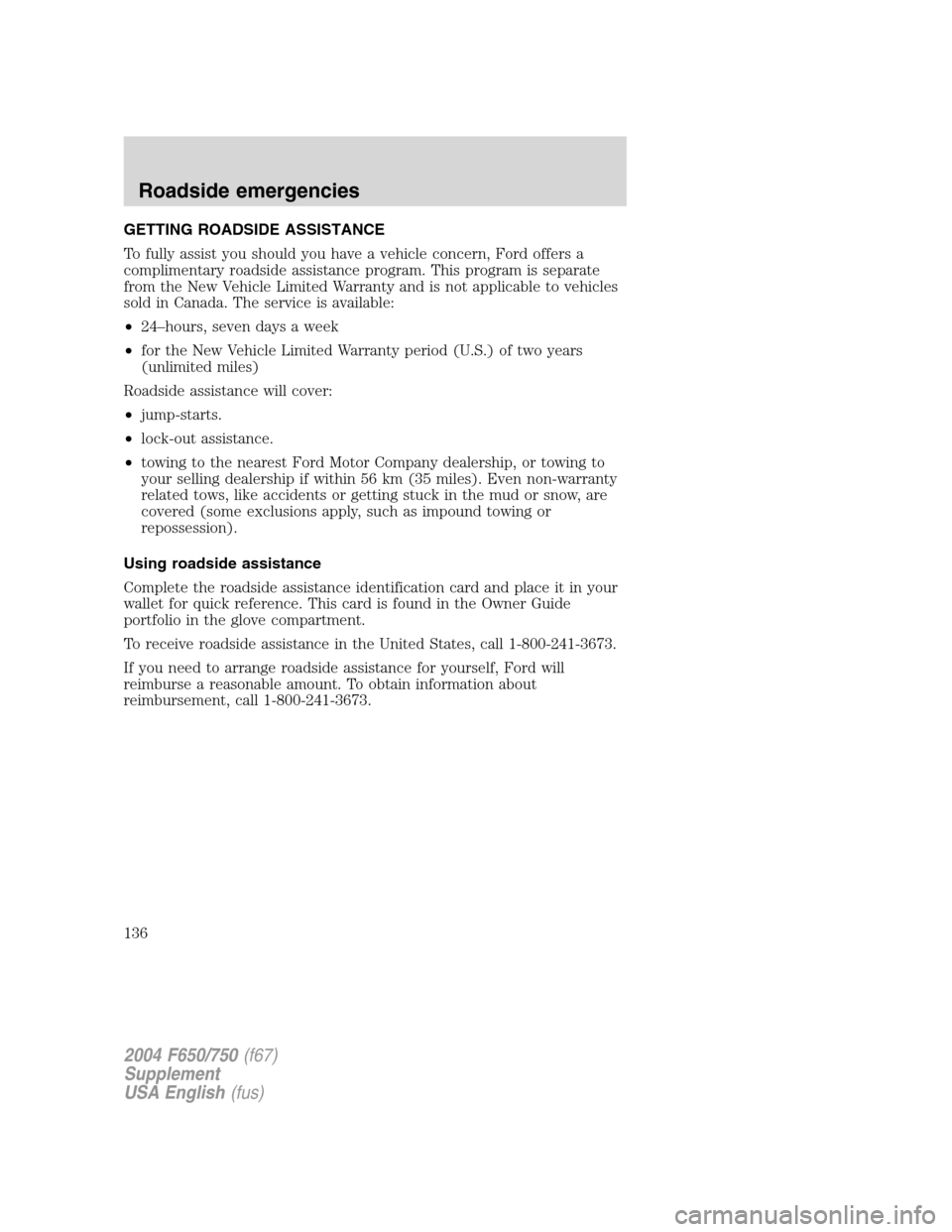
GETTING ROADSIDE ASSISTANCE
To fully assist you should you have a vehicle concern, Ford offers a
complimentary roadside assistance program. This program is separate
from the New Vehicle Limited Warranty and is not applicable to vehicles
sold in Canada. The service is available:
•24–hours, seven days a week
•for the New Vehicle Limited Warranty period (U.S.) of two years
(unlimited miles)
Roadside assistance will cover:
•jump-starts.
•lock-out assistance.
•towing to the nearest Ford Motor Company dealership, or towing to
your selling dealership if within 56 km (35 miles). Even non-warranty
related tows, like accidents or getting stuck in the mud or snow, are
covered (some exclusions apply, such as impound towing or
repossession).
Using roadside assistance
Complete the roadside assistance identification card and place it in your
wallet for quick reference. This card is found in the Owner Guide
portfolio in the glove compartment.
To receive roadside assistance in the United States, call 1-800-241-3673.
If you need to arrange roadside assistance for yourself, Ford will
reimburse a reasonable amount. To obtain information about
reimbursement, call 1-800-241-3673.
2004 F650/750(f67)
Supplement
USA English(fus)
Roadside emergencies
Roadside emergencies
136
Page 137 of 264
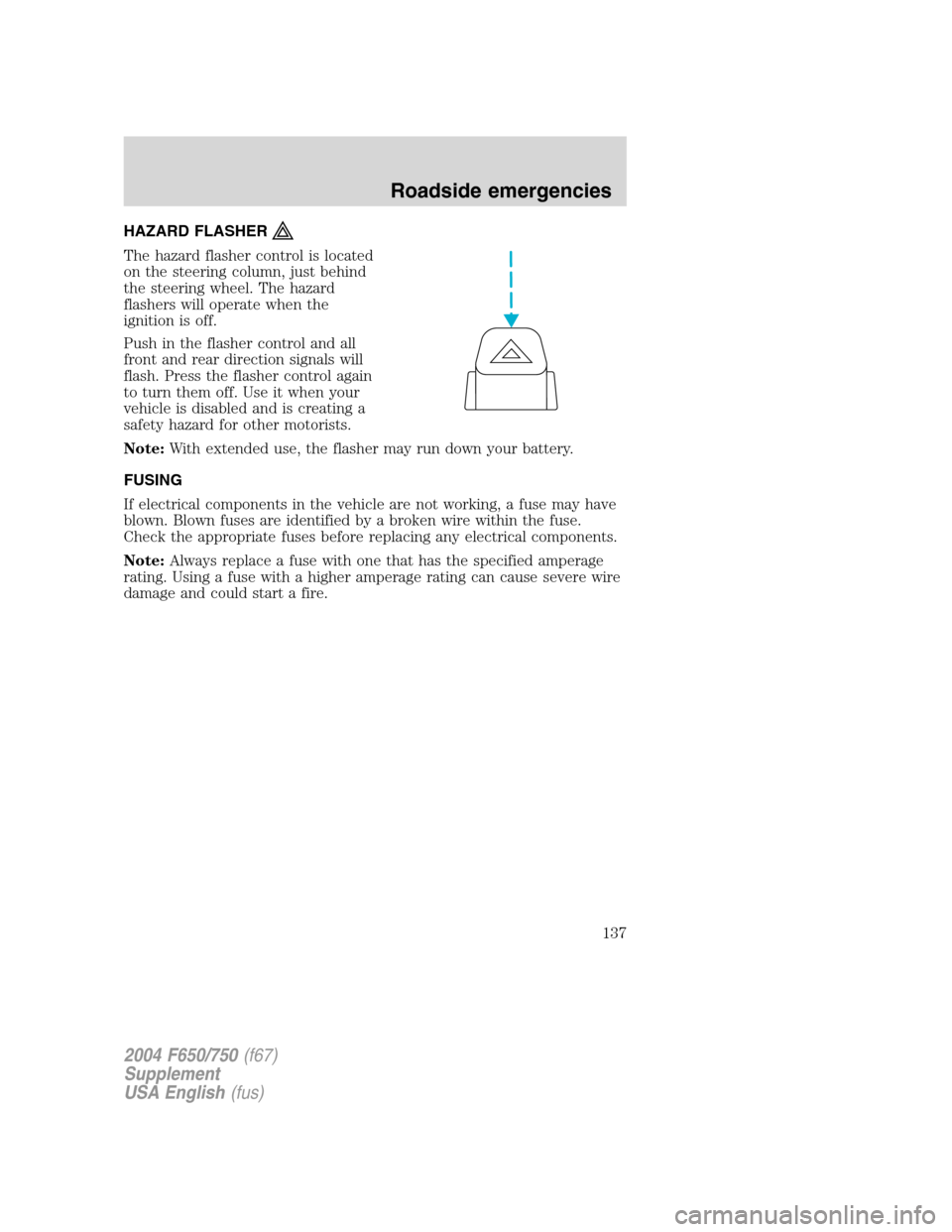
HAZARD FLASHER
The hazard flasher control is located
on the steering column, just behind
the steering wheel. The hazard
flashers will operate when the
ignition is off.
Push in the flasher control and all
front and rear direction signals will
flash. Press the flasher control again
to turn them off. Use it when your
vehicle is disabled and is creating a
safety hazard for other motorists.
Note:With extended use, the flasher may run down your battery.
FUSING
If electrical components in the vehicle are not working, a fuse may have
blown. Blown fuses are identified by a broken wire within the fuse.
Check the appropriate fuses before replacing any electrical components.
Note:Always replace a fuse with one that has the specified amperage
rating. Using a fuse with a higher amperage rating can cause severe wire
damage and could start a fire.
2004 F650/750(f67)
Supplement
USA English(fus)
Roadside emergencies
137
Page 138 of 264
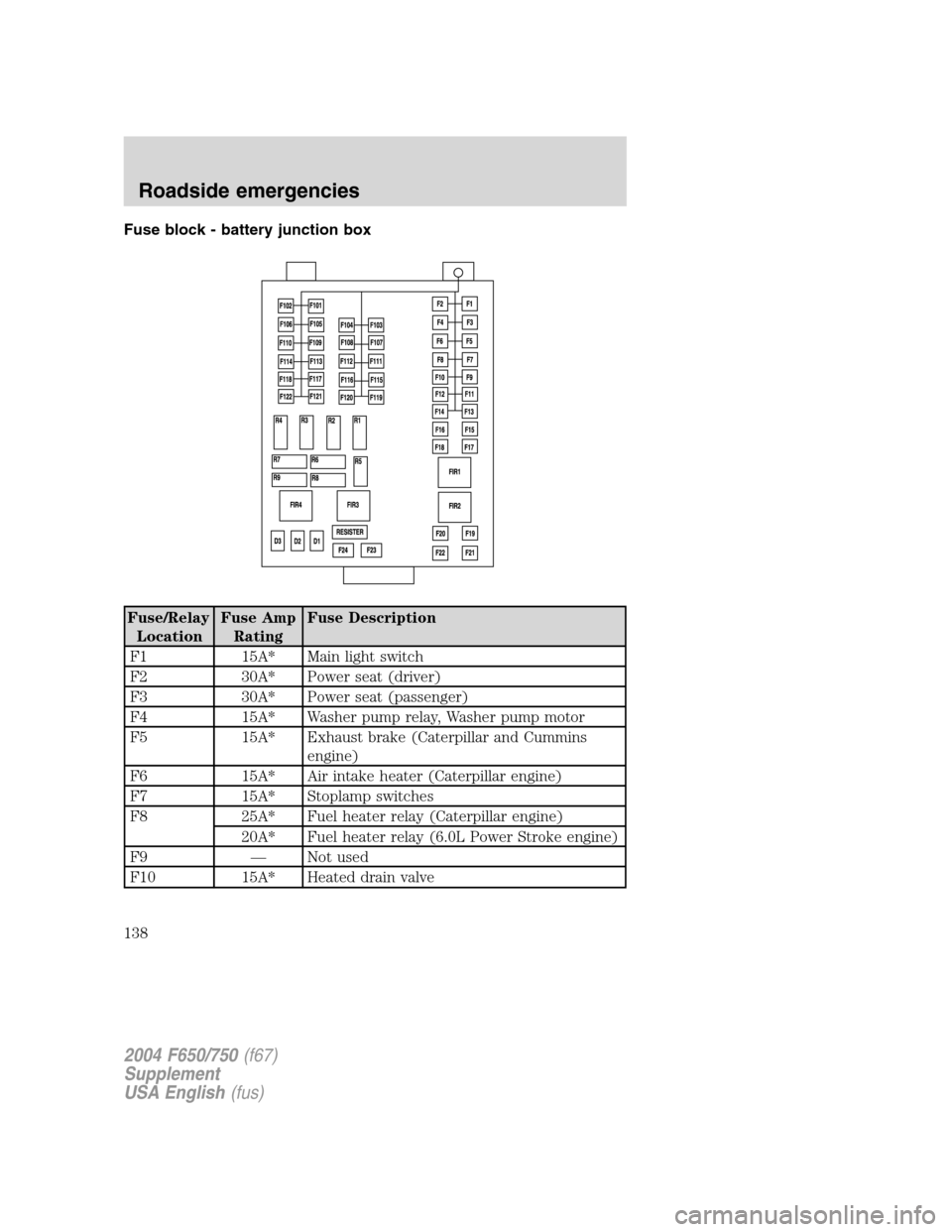
Fuse block - battery junction box
Fuse/Relay
LocationFuse Amp
RatingFuse Description
F1 15A* Main light switch
F2 30A* Power seat (driver)
F3 30A* Power seat (passenger)
F4 15A* Washer pump relay, Washer pump motor
F5 15A* Exhaust brake (Caterpillar and Cummins
engine)
F6 15A* Air intake heater (Caterpillar engine)
F7 15A* Stoplamp switches
F8 25A* Fuel heater relay (Caterpillar engine)
20A* Fuel heater relay (6.0L Power Stroke engine)
F9—Not used
F10 15A* Heated drain valve
2004 F650/750(f67)
Supplement
USA English(fus)
Roadside emergencies
138
Page 139 of 264
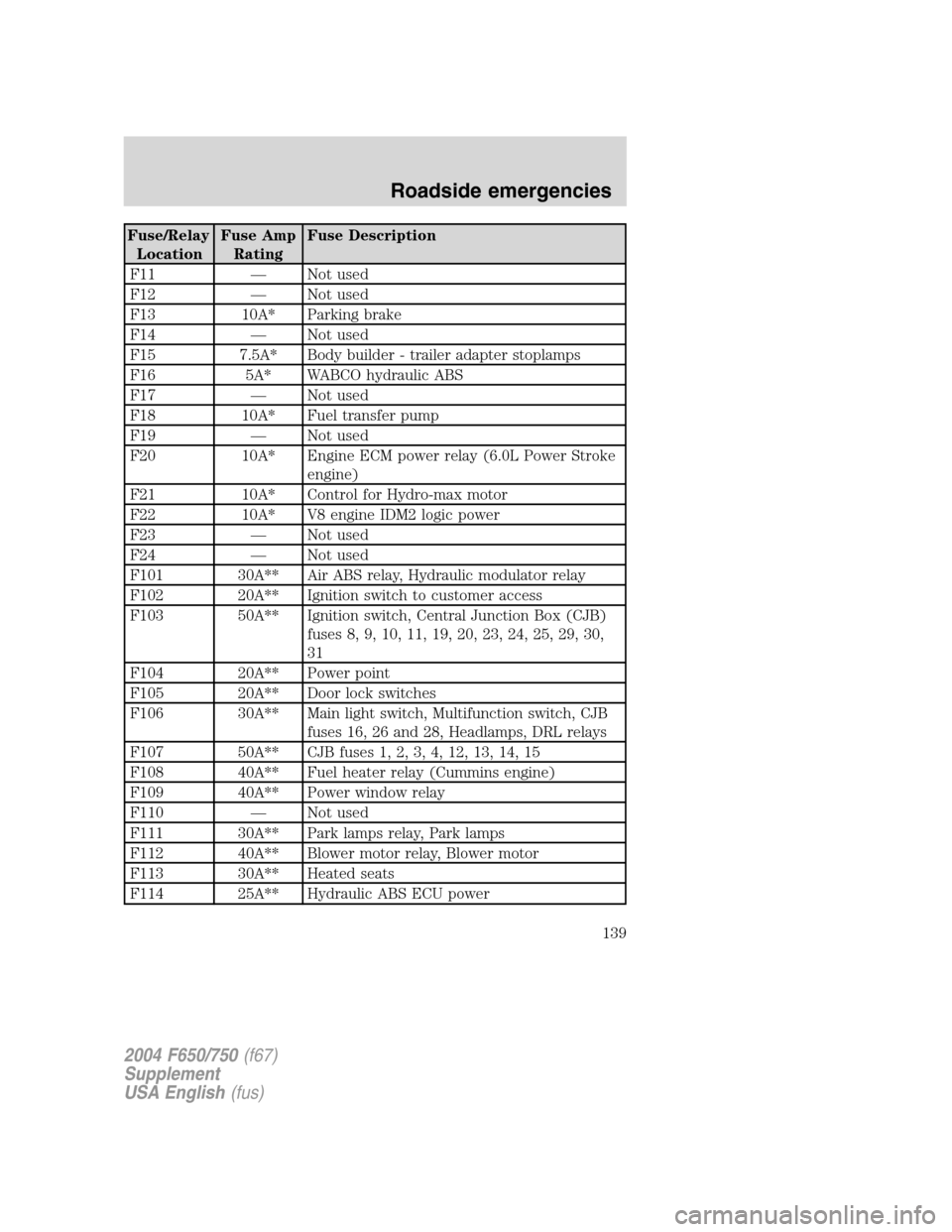
Fuse/Relay
LocationFuse Amp
RatingFuse Description
F11—Not used
F12—Not used
F13 10A* Parking brake
F14—Not used
F15 7.5A* Body builder - trailer adapter stoplamps
F16 5A* WABCO hydraulic ABS
F17—Not used
F18 10A* Fuel transfer pump
F19—Not used
F20 10A* Engine ECM power relay (6.0L Power Stroke
engine)
F21 10A* Control for Hydro-max motor
F22 10A* V8 engine IDM2 logic power
F23—Not used
F24—Not used
F101 30A** Air ABS relay, Hydraulic modulator relay
F102 20A** Ignition switch to customer access
F103 50A** Ignition switch, Central Junction Box (CJB)
fuses 8, 9, 10, 11, 19, 20, 23, 24, 25, 29, 30,
31
F104 20A** Power point
F105 20A** Door lock switches
F106 30A** Main light switch, Multifunction switch, CJB
fuses 16, 26 and 28, Headlamps, DRL relays
F107 50A** CJB fuses 1, 2, 3, 4, 12, 13, 14, 15
F108 40A** Fuel heater relay (Cummins engine)
F109 40A** Power window relay
F110—Not used
F111 30A** Park lamps relay, Park lamps
F112 40A** Blower motor relay, Blower motor
F113 30A** Heated seats
F114 25A** Hydraulic ABS ECU power
2004 F650/750(f67)
Supplement
USA English(fus)
Roadside emergencies
139
Page 140 of 264
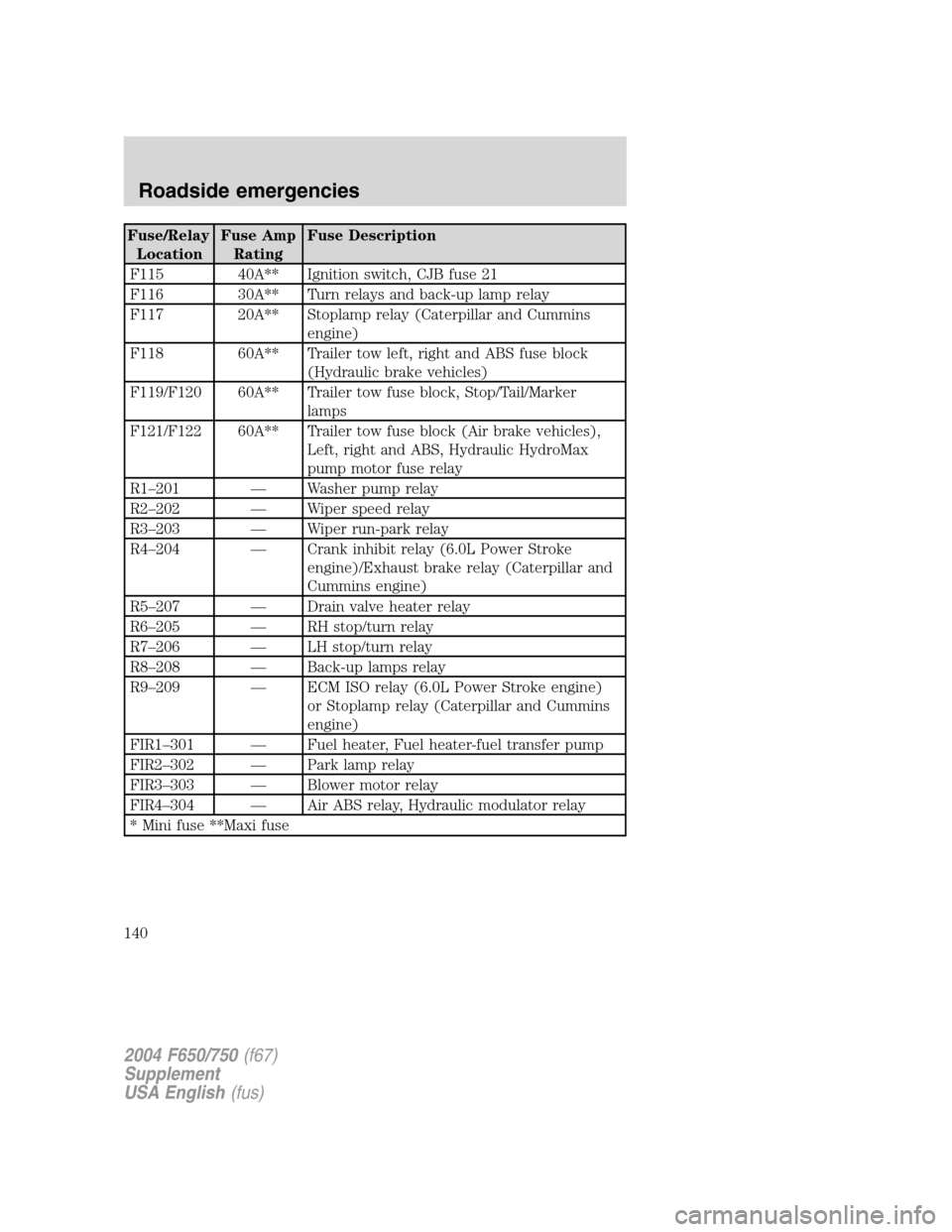
Fuse/Relay
LocationFuse Amp
RatingFuse Description
F115 40A** Ignition switch, CJB fuse 21
F116 30A** Turn relays and back-up lamp relay
F117 20A** Stoplamp relay (Caterpillar and Cummins
engine)
F118 60A** Trailer tow left, right and ABS fuse block
(Hydraulic brake vehicles)
F119/F120 60A** Trailer tow fuse block, Stop/Tail/Marker
lamps
F121/F122 60A** Trailer tow fuse block (Air brake vehicles),
Left, right and ABS, Hydraulic HydroMax
pump motor fuse relay
R1–201—Washer pump relay
R2–202—Wiper speed relay
R3–203—Wiper run-park relay
R4–204—Crank inhibit relay (6.0L Power Stroke
engine)/Exhaust brake relay (Caterpillar and
Cummins engine)
R5–207—Drain valve heater relay
R6–205—RH stop/turn relay
R7–206—LH stop/turn relay
R8–208—Back-up lamps relay
R9–209—ECM ISO relay (6.0L Power Stroke engine)
or Stoplamp relay (Caterpillar and Cummins
engine)
FIR1–301—Fuel heater, Fuel heater-fuel transfer pump
FIR2–302—Park lamp relay
FIR3–303—Blower motor relay
FIR4–304—Air ABS relay, Hydraulic modulator relay
* Mini fuse **Maxi fuse
2004 F650/750(f67)
Supplement
USA English(fus)
Roadside emergencies
140